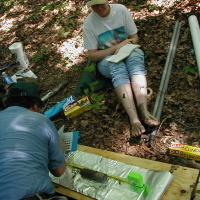Papers by Daniela Vallentin

Neuron, Jan 18, 2016
The zebra finch brain features a set of clearly defined and hierarchically arranged motor nuclei ... more The zebra finch brain features a set of clearly defined and hierarchically arranged motor nuclei that are selectively responsible for producing singing behavior. One of these regions, a critical forebrain structure called HVC, contains premotor neurons that are active at precise time points during song production. However, the neural representation of this behavior at a population level remains elusive. We used two-photon microscopy to monitor ensemble activity during singing, integrating across multiple trials by adopting a Bayesian inference approach to more precisely estimate burst timing. Additionally, we examined spiking and motor-related synaptic inputs using intracellular recordings during singing. With both experimental approaches, we find that premotor events do not occur preferentially at the onsets or offsets of song syllables or at specific subsyllabic motor landmarks. These results strongly support the notion that HVC projection neurons collectively exhibit a temporal s...

Current biology : CB, Jan 5, 2016
The dichotomy between vocal learners and non-learners is a fundamental distinction in the study o... more The dichotomy between vocal learners and non-learners is a fundamental distinction in the study of animal communication. Male zebra finches (Taeniopygia guttata) are vocal learners that acquire a song resembling their tutors', whereas females can only produce innate calls. The acoustic structure of short calls, produced by both males and females, is not learned. However, these calls can be precisely coordinated across individuals. To examine how birds learn to synchronize their calls, we developed a vocal robot that exchanges calls with a partner bird. Because birds answer the robot with stereotyped latencies, we could program it to disrupt each bird's responses by producing calls that are likely to coincide with the bird's. Within minutes, the birds learned to avoid this disruptive masking (jamming) by adjusting the timing of their responses. Notably, females exhibited greater adaptive timing plasticity than males. Further, when challenged with complex rhythms containin...

Science, 2016
Vocal imitation involves incorporating instructive auditory information into relevant motor circu... more Vocal imitation involves incorporating instructive auditory information into relevant motor circuits through processes that are poorly understood. In zebra finches, we found that exposure to a tutor's song drives spiking activity within premotor neurons in the juvenile, whereas inhibition suppresses such responses upon learning in adulthood. We measured inhibitory currents evoked by the tutor song throughout development while simultaneously quantifying each bird's learning trajectory. Surprisingly, we found that the maturation of synaptic inhibition onto premotor neurons is correlated with learning but not age. We used synthetic tutoring to demonstrate that inhibition is selective for specific song elements that have already been learned and not those still in refinement. Our results suggest that structured inhibition plays a crucial role during song acquisition, enabling a piece-by-piece mastery of complex tasks.

Journal of Neuroscience, 2015
In the zebra finch, singing behavior is driven by a sequence of bursts within premotor neurons lo... more In the zebra finch, singing behavior is driven by a sequence of bursts within premotor neurons located in the forebrain nucleus HVC (proper name). In addition to these excitatory projection neurons, HVC also contains inhibitory interneurons with a role in premotor patterning that is unclear. Here, we used a range of electrophysiological and behavioral observations to test previously described models suggesting discrete functional roles for inhibitory interneurons in song production. We show that single HVC premotor neuron bursts are sufficient to drive structured activity within the interneuron network because of pervasive and facilitating synaptic connections. We characterize interneuron activity during singing and describe reliable pauses in the firing of those neurons. We then demonstrate that these gaps in inhibition are likely to be necessary for driving normal bursting behavior in HVC premotor neurons and suggest that structured inhibition and excitation may be a general mechanism enabling sequence generation in other circuits.
Trends in Cognitive Sciences, 2012
Whereas much is known about how we categorize and reason based on absolute quantity, data explori... more Whereas much is known about how we categorize and reason based on absolute quantity, data exploring ratios of quantities, as in proportions and fractions, are comparatively sparse. Until recently, it remained elusive whether these two representations of number are connected, how proportions are implemented by neurons and how language shapes this code. New data derived with complementary methods and from different model systems now shed light on the mechanisms of magnitude ratio representations. A coding scheme for proportions has emerged that is remarkably reminiscent of the representation of absolute number. These novel findings suggest a sense for ratios that grants the brain automatic access to proportions independently of language and the format of presentation.

The Journal of neuroscience : the official journal of the Society for Neuroscience, Jan 7, 2015
Sensory feedback is crucial for learning and performing many behaviors, but its role in the execu... more Sensory feedback is crucial for learning and performing many behaviors, but its role in the execution of complex motor sequences is poorly understood. To address this, we consider the forebrain nucleus HVC in the songbird, which contains the premotor circuitry for song production and receives multiple convergent sensory inputs. During singing, projection neurons within HVC exhibit precisely timed synaptic events that may represent the ongoing motor program or song-related sensory feedback. To distinguish between these possibilities, we recorded the membrane potential from identified HVC projection neurons in singing zebra finches. External auditory perturbations during song production did not affect synaptic inputs in these neurons. Furthermore, the systematic removal of three sensory feedback streams (auditory, proprioceptive, and vagal) did not alter the frequency or temporal precision of synaptic activity observed. These findings support a motor origin for song-related synaptic e...

Journal of Neuroscience, 2012
Switching flexibly between behavioral goals is a hallmark of executive control and requires integ... more Switching flexibly between behavioral goals is a hallmark of executive control and requires integration of external and internal information. We recorded single-neuron correlates of different numerical representations (sensory-, working memory-, and rule-related activity) in the dorsal premotor area (PMd), the cingulate motor areas (CMA), and the ventral intraparietal sulcus (VIP) and compared them to previous recordings in the lateral prefrontal cortex (PFC). Two monkeys were trained to encode and memorize numerosities and flexibly switch between two abstract quantitative rules based on rule cues. Almost 20% of randomly selected PFC and PMd neurons significantly represented the numerical rule in a behaviorally relevant manner, approximately twice as many as in the CMA and VIP. Rule selectivity was significantly better for PMd neurons than for PFC cells. Seemingly at the expense of rule selectivity, however, sensory-and memoryrelated numerosity activity was greatly diminished compared with previous delayed match-to-numerosity studies. These findings suggest the involvement of the frontal premotor areas in strategic planning such as rule following. Moreover, the results emphasize that the coding capacities of neurons in association cortical areas are far more dynamic depending on task demands than previously thought.

European Journal of Neuroscience, 2010
The primate prefrontal (PFC) and posterior parietal cortices (PPC) have been shown to be cardinal... more The primate prefrontal (PFC) and posterior parietal cortices (PPC) have been shown to be cardinal structures in processing abstract absolute magnitudes, such as numerosity or length. The neuronal representation of quantity relations, however, remained largely elusive. Recent functional imaging studies in humans showed that blood flow changes systematically both in the PFC and the PPC as a function of relational distance between proportions. We investigated the response properties of single neurons in the lateral PFC and the inferior parietal lobule (IPL, area 7) in rhesus monkeys performing a lengths-proportion-discrimination task. Neurons in both areas shared many characteristics and showed peaked tuning functions with preferred proportions. However, a significantly higher percentage of neurons coding proportions was found in the PFC compared with the IPL. In agreement with human studies, our study shows that proportions are represented in the fronto-parietal network that has already been implicated for absolute magnitude processing.

Current Biology, 2008
Primate brains are equipped with evolutionarily old and dedicated neural circuits so that they ca... more Primate brains are equipped with evolutionarily old and dedicated neural circuits so that they can grasp absolute quantities, such as the number of items or the length of a line . Absolute magnitude, however, is often not informative enough to guide decisions in conflicting social and foraging situations that require an assessment of quantity ratios. We report that rhesus monkeys can discriminate proportions (1:4, 2:4, 3:4, and 4:4) specified by bars differing in lengths and that they can do so at a precision comparable to that shown by humans; the monkeys thus demonstrate an abstract understanding of proportionality. Moreover, neurons in the lateral prefrontal cortex selectively responded to preferred proportions regardless of the exact physical appearance of the stimuli. These results support the hypothesis that nonhuman primates can judge proportions and utilize the underlying information in behaviorally relevant situations.

The Journal of neuroscience : the official journal of the Society for Neuroscience, Jan 3, 2014
High-frequency ripple oscillations, observed most prominently in the hippocampal CA1 pyramidal la... more High-frequency ripple oscillations, observed most prominently in the hippocampal CA1 pyramidal layer, are associated with memory consolidation. The cellular and network mechanisms underlying the generation of the rhythm and the recruitment of spikes from pyramidal neurons are still poorly understood. Using intracellular, sharp electrode recordings in freely moving, drug-free mice, we observed consistent large depolarizations in CA1 pyramidal cells during sharp wave ripples, which are associated with ripple frequency fluctuation of the membrane potential ("intracellular ripple"). Despite consistent depolarization, often exceeding pre-ripple spike threshold values, current pulse-induced spikes were strongly suppressed, indicating that spiking was under the control of concurrent shunting inhibition. Ripple events were followed by a prominent afterhyperpolarization and spike suppression. Action potentials during and outside ripples were orthodromic, arguing against ectopic spi...










Uploads
Papers by Daniela Vallentin